Performance Assessment and Working Fluid Selection for Novel Integrated Vapor Compression Cycle and Organic Rankine Cycle for Ultra Low Grade Waste Heat Recovery
Abstract
:1. Introduction
2. Materials and Methods
2.1. Working Fluid Selection
2.2. Research Approach
- The system is operating under a steady state.
- The two cycles utilize different working fluids.
- Friction, heat loss, changes in kinetic and potential energy are neglected.
- Pressure drops in heat exchangers and pipe work are neglected.
- The VCC refrigerant enters the compressor as a saturated vapor and exits the condenser as a saturated liquid.
- The expansion process in the VCC is adiabatic.
- The working fluid in the ORC exits the condenser as a saturated liquid and enters the turbine as a saturated vapor.
- The effect on the VCC subsystem by the ORC subsystem can be neglected.
2.3. Model Validation
2.4. Component Sizing
2.4.1. Evaporator and Condenser Model
2.4.2. Expander Model
2.4.3. Pump Model
3. Results and Discussion
Integrated VCC-ORC System-Recovery of Heat from VCC Condenser
4. Conclusions
- As the designed VCC condensation temperature increases, there is an increase in net electricity production, system exergy destruction and ORC exergy efficiency, whereas the net COP and system exergy efficiency decrease.
- With an increase in the condensing water temperature, the net electricity and net COP show a linear decline. Similarly, the system exergy efficiency and system exergy destruction also decrease as the condensing water temperature decreases.
- When the mass flow rate of the condensing water increases, there is an increase in the net COP, net electricity, ORC exergy efficiency and system exergy destruction, whereas there is a slight increase in the system exergy efficiency with an increasing mass flow rate.
- With an increasing return chilled water temperature, the net COP, net electricity and system exergy destruction increase, while the exergy efficiency decreases.
Author Contributions
Funding
Institutional Review Board Statement
Informed Consent Statement
Data Availability Statement
Acknowledgments
Conflicts of Interest
Nomenclature
| a | heat transfer coefficient: W/m2K | cf | cold fluid |
| comb | combined | ||
| A | heat transfer area, m2 | comp | compressor |
| Bo | boiling number | cond | condenser |
| Dh | hydraulic diameter, m | cr | critical |
| E | electricity, kW | evap | evaporator |
| G | mass flux, kg/m2s | eq | equivalent |
| Ge1, Ge2 | correlation coefficients | ex | exergy |
| h | specific enthalpy, kJ/kg | f | saturated liquid |
| ifg | enthalpy of vaporization, J/kg | g | generator |
| k | thermal conductivity, W/mK | hf | hot fluid |
| m | mass flow rate, kg/s | i | region part |
| M | molar mass, kg/kmol | ini | initial |
| Nu | Nusselt number | l | liquid |
| P | pressure, MPa | m | average value for the two-phase mixture |
| Pco | heat exchanger pitch | r | refrigerant |
| Pr | Prandtl number | reco | recovery |
| q | heat flux, W/m2 | exp | expander |
| Q | energy, kW | v | saturated vapor |
| Re | Reynolds number | valve | expansion valve |
| s | specific entropy, kJ/(kg·K) | ||
| T | temperature, °C | ||
| T0 | dead state temperature, K | ||
| V | volumetric flow rate, m3/s | Acronyms | |
| W | power, kW | ||
| x | vapor quality | GWP | global warming potential |
| i-VCC-ORC | Integrated vapor compression cycle-organic Rankine cycle | ||
| Greek symbols | |||
| η | efficiency | ||
| β | chevron angle, radian | ODP | ozone depletion potential |
| μ | dynamic viscosity, Ns/m2 | SHX | shared heat exchanger |
| Subscripts | WHR | waste heat recovery | |
| 1-12 | state points |
References
- Moles, F.; Navarro-Esbrí, J.; Peris, B.; Mota-Babiloni, A.; Kontomaris, K. Kostas, Thermodynamic analysis of a combined organic Rankine cycle and vapor compression cycle system activated with low temperature heat sources using low GWP fluids. Appl. Therm. Eng. 2015, 87, 444–453. [Google Scholar] [CrossRef]
- Imran, M.; Usman, M.; Yang, Y.; Park, B.-S. Flow boiling of R245fa in the brazed plate heat exchanger: Thermal and hydraulic performance assessment. Int. J. Heat Mass Transf. 2017, 110, 657–670. [Google Scholar] [CrossRef]
- Quoilin, S. Sustainable Energy Conversion through the Use of Organic Rankine Cycles for Waste Heat Recovery and Solar Applications. Ph.D. Thesis, University of Liège, Liège, Belgium, 2011. [Google Scholar]
- Baral, S.; Kim, D.; Yun, E.; Kim, K.C. Energy, Exergy and Performance Analysis of Small-Scale Organic Rankine Cycle Systems for Electrical Power Generation Applicable in Rural Areas of Developing Countries. Energies 2015, 8, 684–713. [Google Scholar] [CrossRef] [Green Version]
- Yun, E.; Kim, D.; Yoon, S.Y.; Kim, K.C. Experimental investigation of an organic Rankine cycle with multiple expanders used in parallel. Appl. Energy 2015, 145, 246–254. [Google Scholar] [CrossRef]
- Katili, A.; Boukhanouf, R.; Wilson, R. Space Cooling in Buildings in Hot and Humid Climates—A Review of the Effect of Humidity on the Applicability of Existing Cooling Techniques. In Proceedings of the 14th International Conference on Sustainable Energy Technologies, Nottingham, UK, 25–27 August 2015; pp. 25–27. [Google Scholar]
- Hong Kong Government. Hong Kong End User Data Report 2017. 2017. Available online: http://www.enb.gov.hk/sites/default/files/pdf/ClimateChangeEng.pdf (accessed on 26 February 2018).
- Prigmore, D.; Barber, R. Cooling with the sun’s heat Design considerations and test data for a Rankine Cycle prototype. Sol. Energy 1975, 17, 185–192. [Google Scholar] [CrossRef]
- Nasir, M.T.; Kim, K.C. Working fluids selection and parametric optimization of an Organic Rankine Cycle coupled Vapor Compression Cycle (ORC-VCC) for air conditioning using low grade heat. Energy Build. 2016, 129, 378–395. [Google Scholar] [CrossRef]
- Nasir, M.T.; Ali, M.A.; Khan, T.S.; Al-Hajri, E.; Kadri, M.B.; Kim, K.C. Performance assessment and multi objective optimization of an Organic Rankine Cycle driven cooling air conditioning system. Energy Build. 2019, 191, 13–30. [Google Scholar] [CrossRef]
- Nasir, M.T.; Ekwonu, M.C.; Esfahani, J.A.; Kim, K.C. Performance assessment and multi-objective optimization of an organic Rankine cycles and vapor compression cycle based combined cooling, heating, and power system. Sustain. Energy Technol. Assess. 2021, 47, 101457. [Google Scholar] [CrossRef]
- Asim, M.; Leung, M.K.; Shan, Z.; Li, Y.; Leung, D.Y.; Ni, M. Thermodynamic and Thermo-economic Analysis of Integrated Organic Rankine Cycle for Waste Heat Recovery from Vapor Compression Refrigeration Cycle. Energy Procedia 2017, 143, 192–198. [Google Scholar] [CrossRef]
- Bao, J.; Zhang, L.; Song, C.; Zhang, N.; Zhang, X.; He, G. Comparative study of combined organic Rankine cycle and vapor compression cycle for refrigeration: Single fluid or dual fluid? Sustain. Energy Technol. Assess. 2020, 37, 100595. [Google Scholar] [CrossRef]
- Aphornratana, S.; Sriveerakul, T. Analysis of a combined Rankine–vapour–compression refrigeration cycle. Energy Convers. Manag. 2010, 51, 2557–2564. [Google Scholar] [CrossRef]
- Kim, K.H.; Perez-Blanco, H. Performance analysis of a combined organic Rankine cycle and vapor compression cycle for power and refrigeration cogeneration. Appl. Therm. Eng. 2015, 91, 964–974. [Google Scholar] [CrossRef]
- Toujani, N.; Bouaziz, N.; Chrigui, M.; Kairouani, L. The Impact of Operating Parameters on the Performance of a New ORC–VCC Combination for Cogeneration. Therm. Eng. 2020, 67, 660–672. [Google Scholar] [CrossRef]
- Saleh, B. Parametric and working fluid analysis of a combined organic Rankine-vapor compression refrigeration system activated by low-grade thermal energy. J. Adv. Res. 2016, 7, 651–660. [Google Scholar] [CrossRef] [Green Version]
- Kim, D.K.; Lee, J.S.; Kim, J.; Kim, M.S.; Kim, M.S. Parametric study and performance evaluation of an organic Rankine cycle (ORC) system using low-grade heat at temperatures below 80 °C. Appl. Energy 2017, 189, 55–65. [Google Scholar] [CrossRef]
- Javanshir, N.; Mahmoudi, S.M.S.; Rosen, M.A. Thermodynamic and Exergoeconomic Analyses of a Novel Combined Cycle Comprised of Vapor-Compression Refrigeration and Organic Rankine Cycles. Sustainability 2019, 11, 3374. [Google Scholar] [CrossRef] [Green Version]
- Zhao, P.; Wang, J.; Gao, L.; Dai, Y. Parametric analysis of a hybrid power system using organic Rankine cycle to recover waste heat from proton exchange membrane fuel cell. Int. J. Hydrog. Energy 2012, 37, 3382–3391. [Google Scholar] [CrossRef]
- Liang, Y.; Yu, Z.; Li, W. A Waste Heat-Driven Cooling System Based on Combined Organic Rankine and Vapour Compression Refrigeration Cycles. Appl. Sci. 2019, 9, 4242. [Google Scholar] [CrossRef] [Green Version]
- Lakew, A.A.; Bolland, O. Working fluids for low-temperature heat source. Appl. Therm. Eng. 2010, 30, 1262–1268. [Google Scholar] [CrossRef]
- Kumar, R.; Memon, A.G.; bin Tariq, A.; Yousfani, F.M. Energy Analysis and Working Fluid Selection of Combined ORC-VCC Refrigeration System Operated by Low-Grade Thermal Energy Sources. In Proceedings of the 2021 4th International Conference on Energy Conservation and Efficiency (ICECE), Lahore, Pakistan, 16–17 March 2021; pp. 1–6. [Google Scholar] [CrossRef]
- Habibzadeh, A.; Rashidi, M.M.; Galanis, N. Analysis of a combined power and ejector-refrigeration cycle using low temperature heat. Energy Convers. Manag. 2013, 65, 381–391. [Google Scholar] [CrossRef]
- Bao, J.; Zhao, L. A review of working fluid and expander selections for organic Rankine cycle. Renew. Sustain. Energy Rev. 2013, 24, 325–342. [Google Scholar] [CrossRef]
- Feng, Y.; Hung, T.; Greg, K.; Zhang, Y.; Li, B.; Yang, J. Thermoeconomic comparison between pure and mixture working fluids of organic Rankine cycles (ORCs) for low temperature waste heat recovery. Energy Convers. Manag. 2015, 106, 859–872. [Google Scholar] [CrossRef]
- Badr, O.; O’callaghan, P.W.; Probert, S.D. Vapour-Compression Refrigeration Systems. 1990. Available online: https://ac.els-cdn.com/030626199090004W/1-s2.0-030626199090004W-main.pdf?_tid=383449b4-ae49-4001-b4e9-a218dcb8c9e6&acdnat=1537780829_f4803544debe59e8b9943b9de51d1182 (accessed on 24 September 2018).
- Tchanche, B.F.; Papadakis, G.; Lambrinos, G.; Frangoudakis, A. Fluid selection for a low-temperature solar organic Rankine cycle. Appl. Therm. Eng. 2009, 29, 2468–2476. [Google Scholar] [CrossRef] [Green Version]
- Imran, M.; Usman, M.; Park, B.-S.; Yang, Y. Comparative assessment of Organic Rankine Cycle integration for low temperature geothermal heat source applications. Energy 2016, 102, 473–490. [Google Scholar] [CrossRef]
- Hsieh, Y.; Lin, T. Saturated flow boiling heat transfer and pressure drop of refrigerant R-410A in a vertical plate heat exchanger. Int. J. Heat Mass Transf. 2002, 45, 1033–1044. [Google Scholar] [CrossRef]
- Selvam, M.A.J.; Kumar, P.S.; Muthuraman, S. The characteristics of brazed plate heat exchangers with different chevron angles. J. Eng. Appl. Sci. 2009, 4, 19–26. [Google Scholar] [CrossRef]
- Han, D.-H.; Lee, K.-J.; Kim, Y.-H. The Characteristics of Condensation in Brazed Plate Heat Exchangers with Different Chevron Angles. J. Korean Phys. Soc. 2003, 43, 66–73. [Google Scholar]
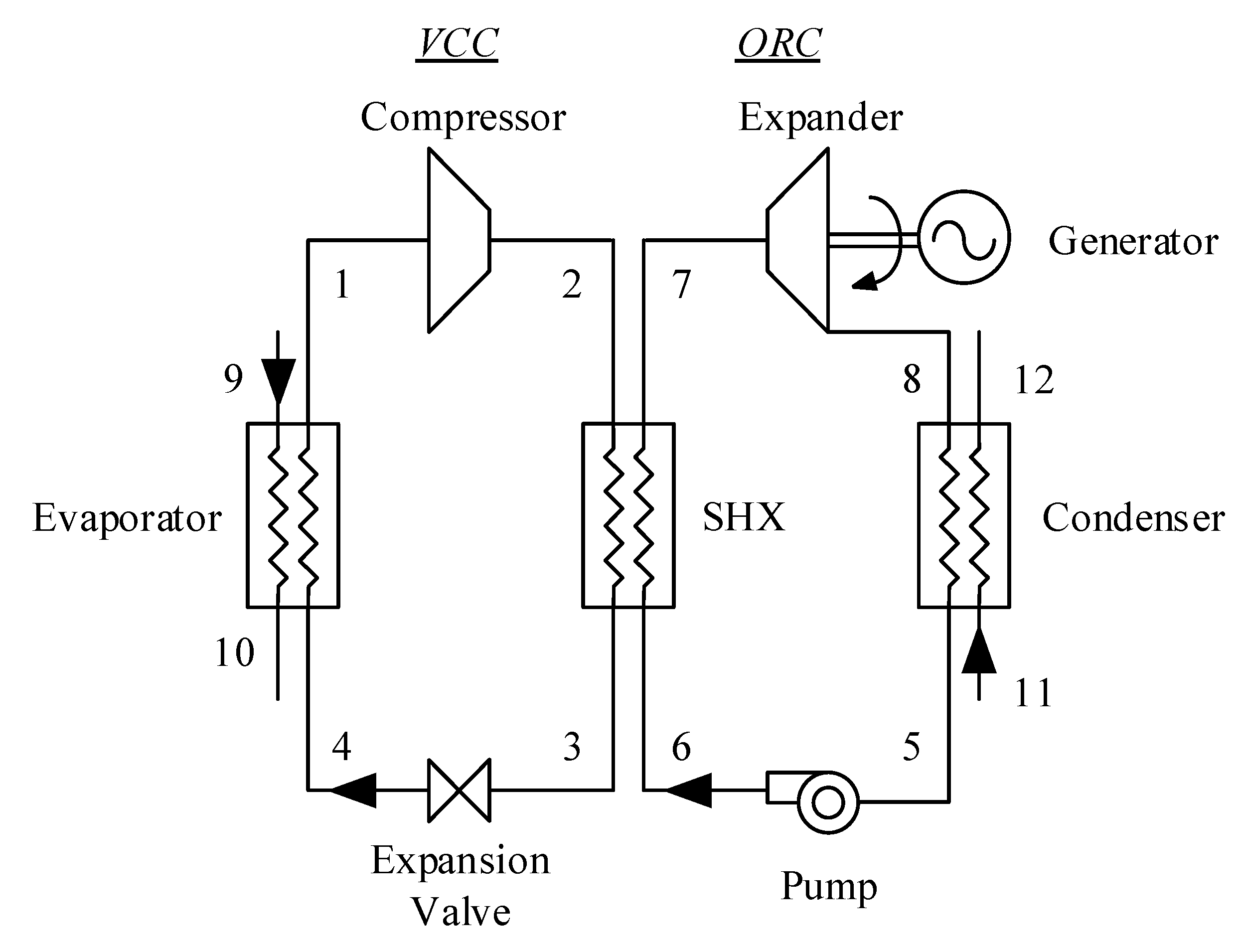
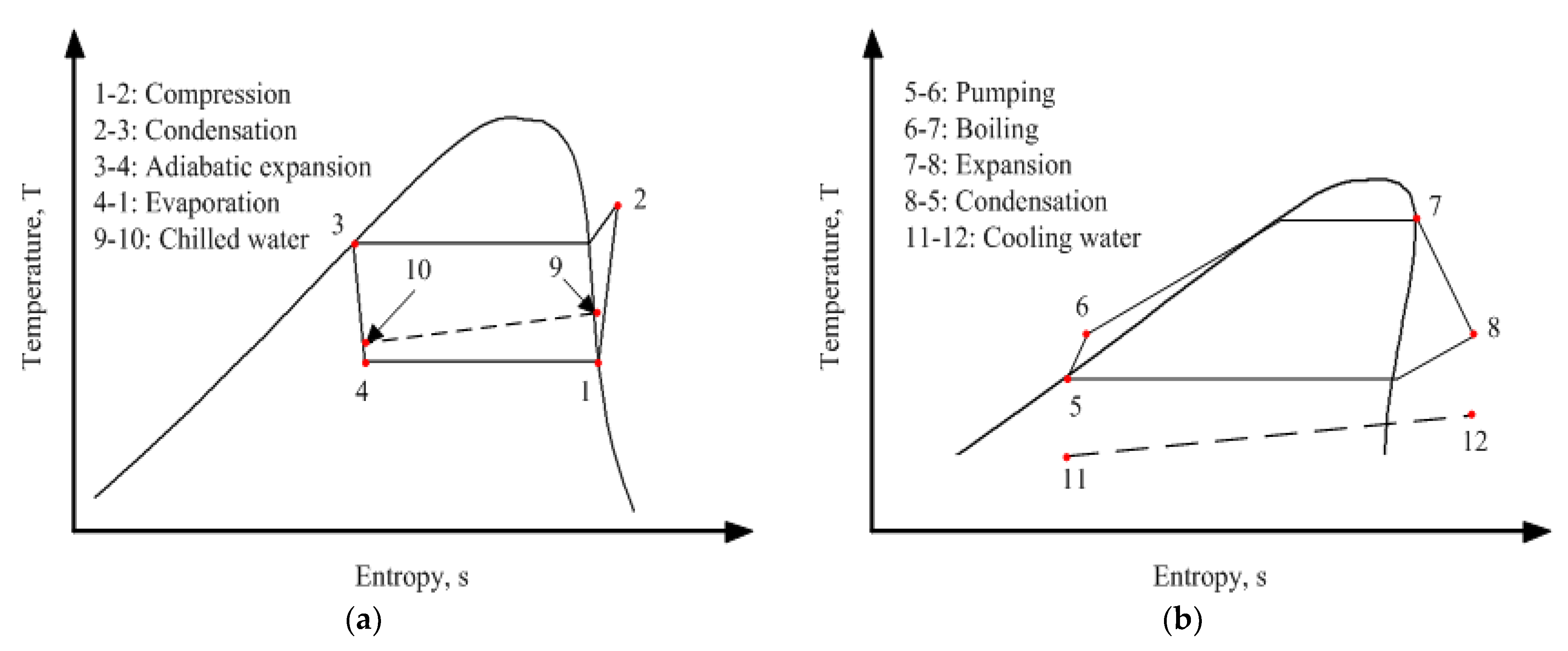
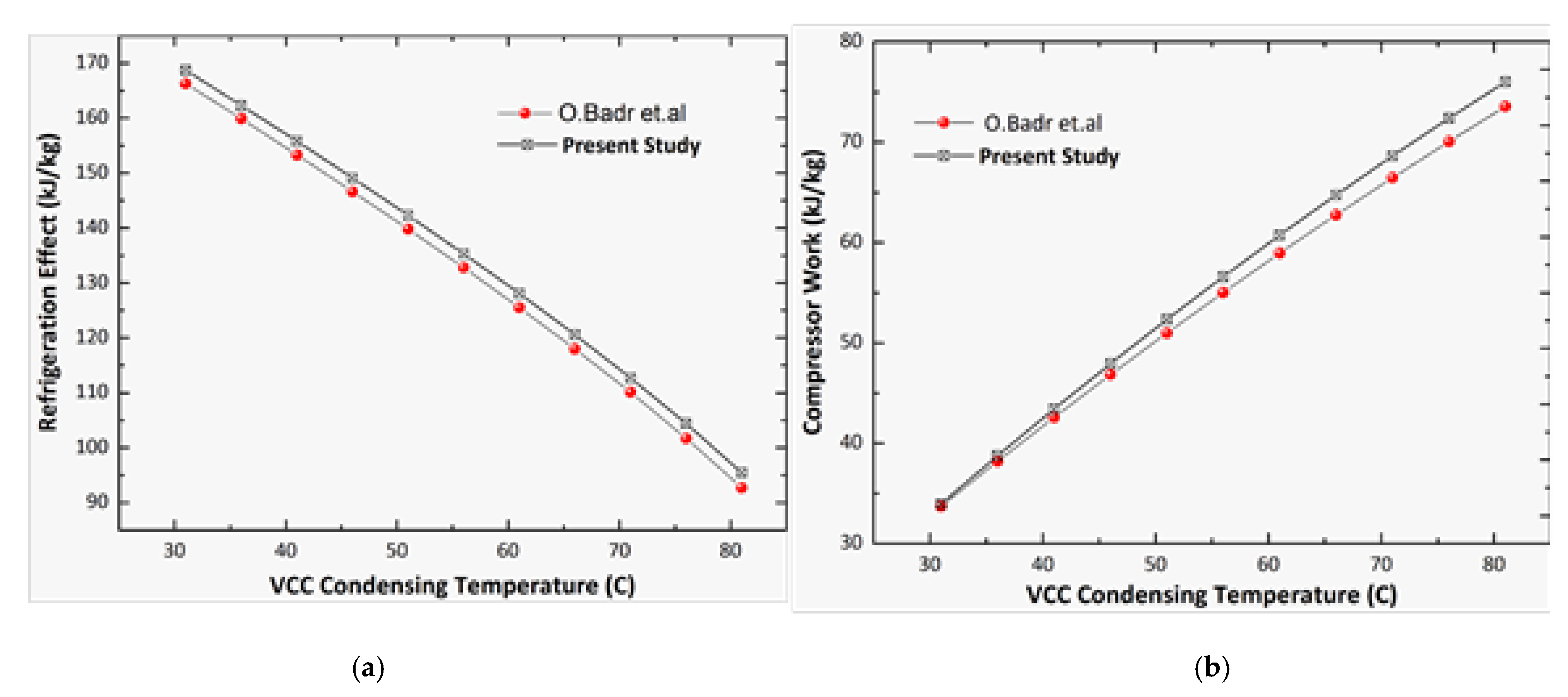
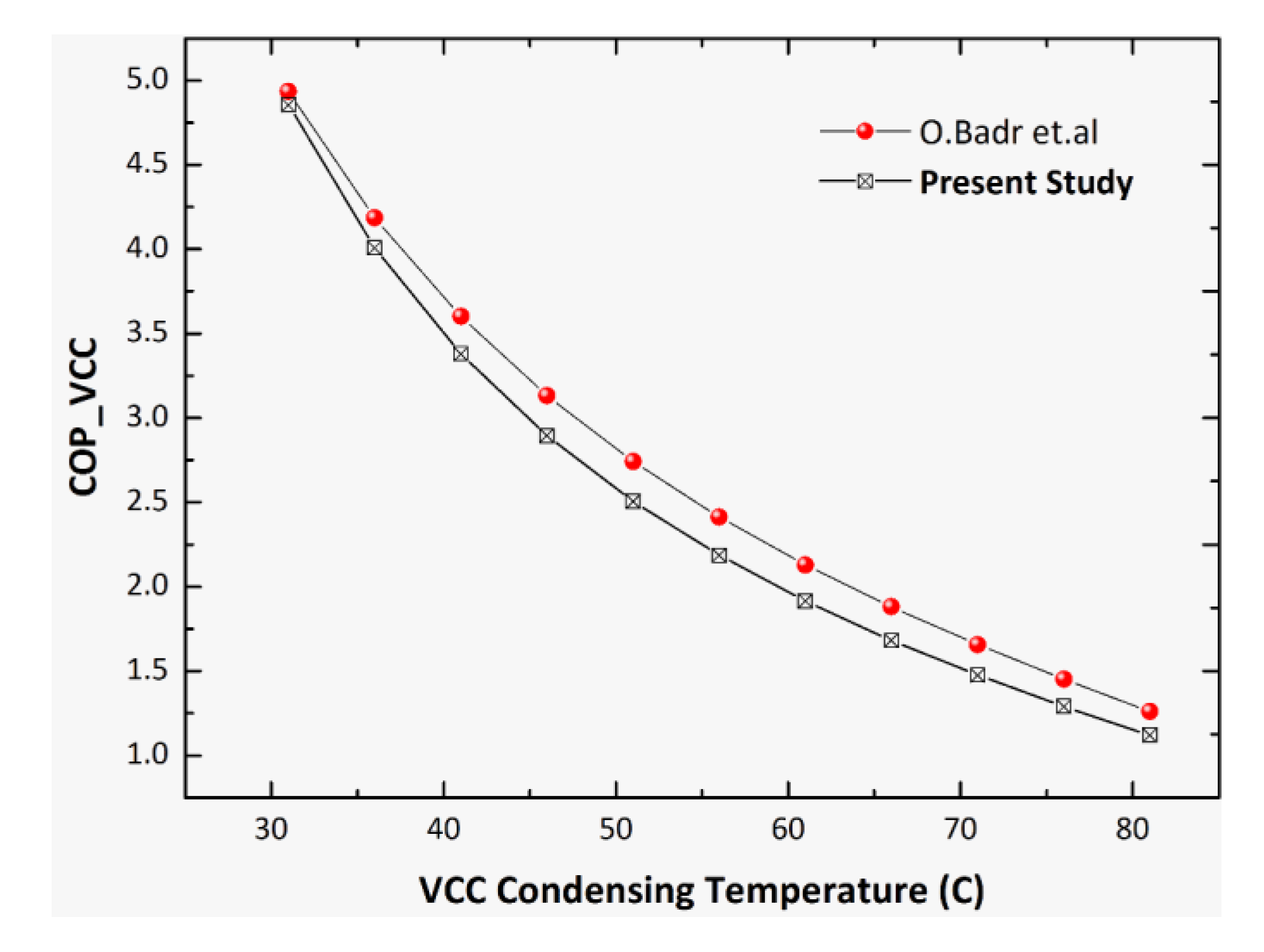
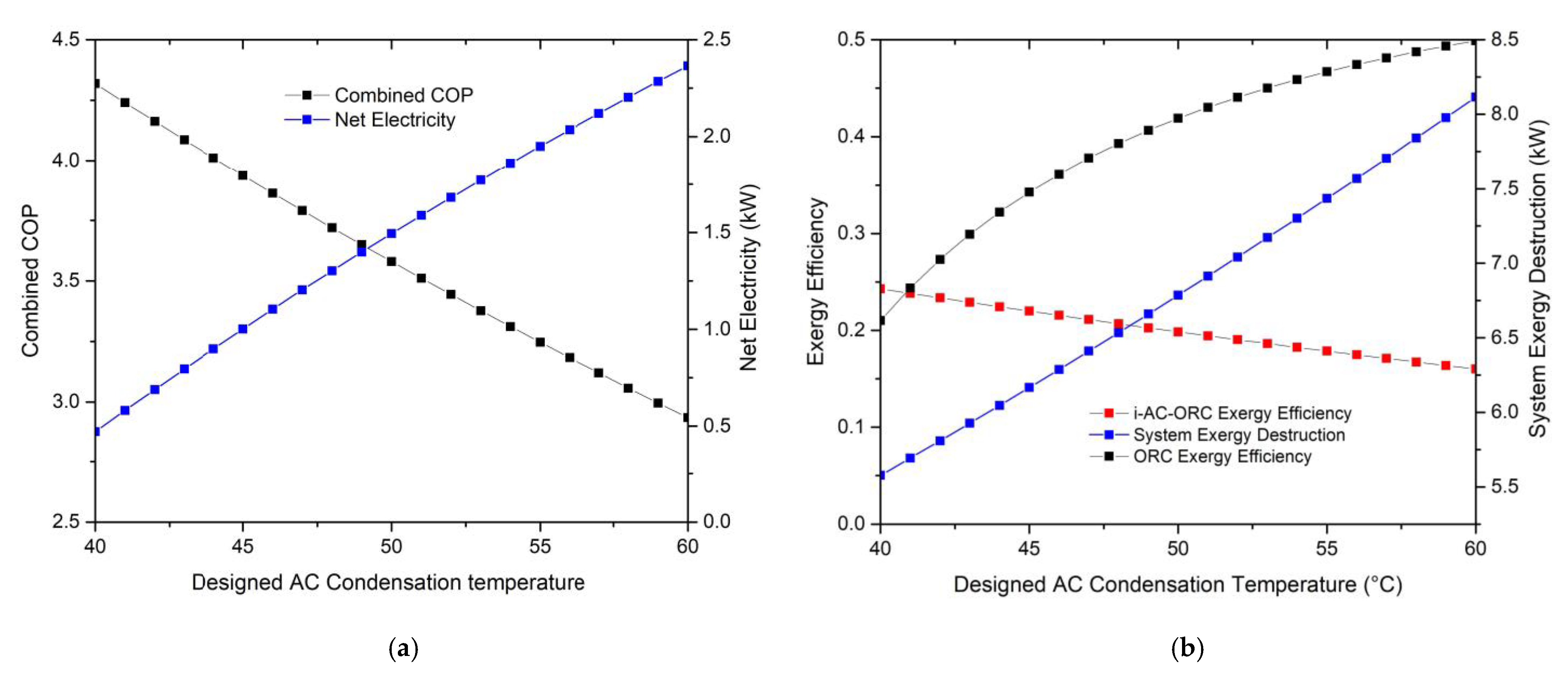
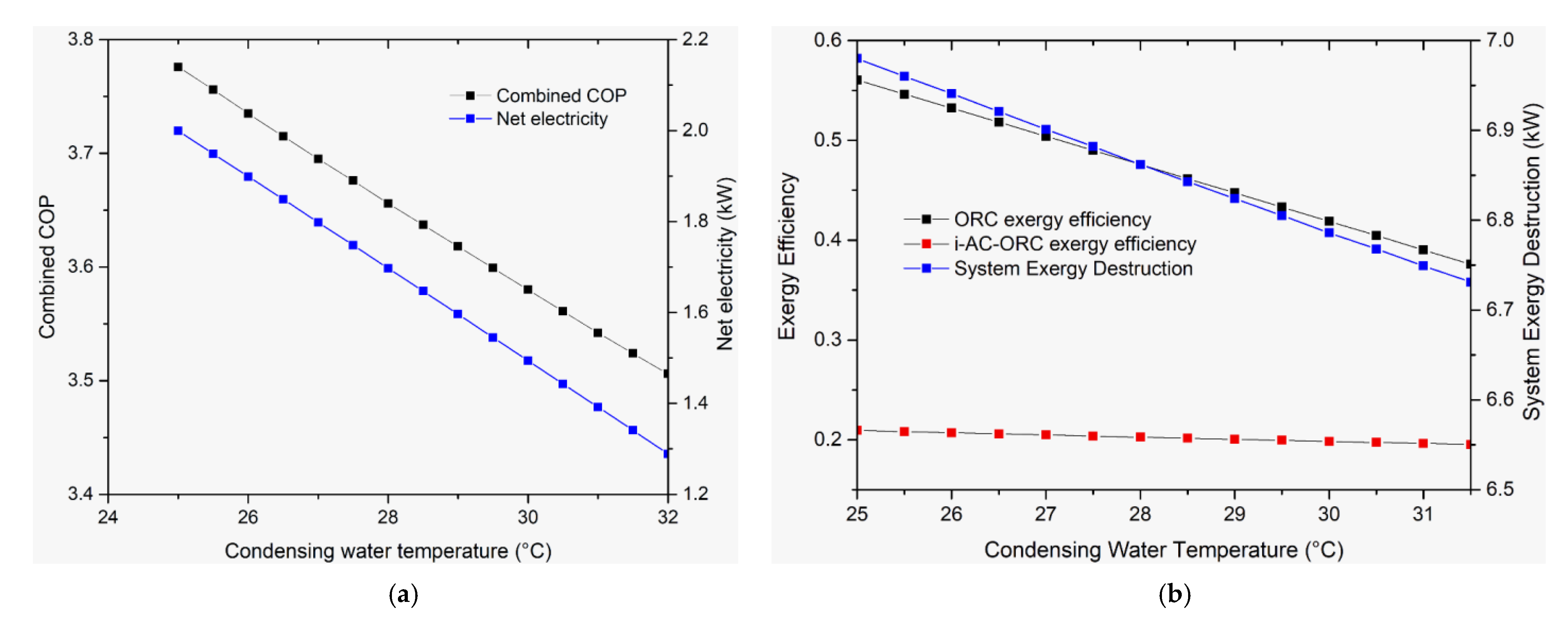


| System | Working Fluids | M (kg/kmol) | Tcr (°C) | Pcr (MPa) | ODP | GWP (for 100 Years) |
|---|---|---|---|---|---|---|
| VCC | R134a | 102.03 | 101.1 | 4.06 | 0 | 1430 |
| R290 | 44.10 | 96.7 | 4.25 | 0 | 20 | |
| R404A | 97.60 | 72.0 | 3.72 | 0 | 3900 | |
| R407C | 86.20 | 85.8 | 4.60 | 0 | 1800 | |
| R600a | 58.12 | 134.7 | 3.63 | 0 | 20 | |
| R410A | 72.58 | 70.5 | 4.81 | 0 | 2100 | |
| ORC | Butane | 58.12 | 152.0 | 3.80 | 0 | 20 |
| R123 | 152.93 | 183.7 | 3.66 | 0.02 | 77 | |
| R141b | 116.95 | 204.4 | 4.21 | 0.12 | 725 | |
| R227ea | 170.03 | 102.8 | 3.00 | 0 | 3220 | |
| R245fa | 134.05 | 154.0 | 3.65 | 0 | 1030 | |
| R1233zd(e) | 130.49 | 166.5 | 3.62 | 0.00034 | 7 |
| Parameters | Units | Values |
|---|---|---|
| Heat input to VCC system | kW | 35 |
| Return chilled water temperature | °C | 12 |
| Condensing water temperature | °C | 30 |
| VCC condensation temperature | °C | 50 |
| ORC condensation temperature | °C | 35 |
| Indoor air temperature | °C | 25 |
| Ambient air temperature | °C | 35 |
| Dead state temperature | °C | 25 |
| VCC evaporator pinch point | °C | 06 |
| ORC condenser pinch point | °C | 03 |
| Mass flow rate of condensing water | kg/s | 4 |
| Mass flow rate of chilled water | kg/s | 1.7 |
| Return chilled water pressure | MPa | 0.101 |
| Inlet cooling water pressure | MPa | 0.101 |
| Indoor air pressure | MPa | 0.101 |
| Compressor efficiency | [%] | 70 |
| Expander efficiency | [%] | 80 |
| Pump efficiency | [%] | 80 |
| Generator efficiency | [%] | 95 |
| Evaporation Temperature | Te | 75 °C |
|---|---|---|
| Condensing temperature | Tc | 35 °C |
| Expander isentropic efficiency | ηexp | 0.70 |
| Pump efficiency | ηp | 0.80 |
| Expander mechanical efficiency | ηmt | 0.63 |
| Refrigerant | Type | Comparison | Pmin | Pmax | mwf | Thermal Efficiency | % Variation |
|---|---|---|---|---|---|---|---|
| kPa | kPa | kg/s | % | % | |||
| RC318 | Dry | B.F. Tchanche et al. | 425 | 1201 | 0.381 | 3.715 | 4.76 |
| Present Study | 417 | 1014 | 0.571 | 3.538 | |||
| R114 | Dry | B.F. Tchanche et al. | 290 | 826 | 0.305 | 4.122 | 6.59 |
| Present Study | 249 | 706 | 0.363 | 3.850 | |||
| R600 | Dry | B.F. Tchanche et al. | 329 | 907 | 0.108 | 4.236 | 4.95 |
| Present Study | 325 | 882 | 0.112 | 4.446 | |||
| R141b | Isentropic | B.F. Tchanche et al. | 112 | 371 | 0.173 | 4.526 | 3.18 |
| Present Study | 112 | 358 | 0.173 | 4.670 | |||
| R123 | Isentropic | B.F. Tchanche et al. | 130 | 431 | 0.227 | 4.457 | 3.66 |
| Present Study | 130 | 416 | 0.226 | 4.620 |
| VCC Working Fluid | ORC Working Fluid | COPini | COPnet | (kW) | ESR (%) | (%) | (%) | (%) | Integrated System | |
|---|---|---|---|---|---|---|---|---|---|---|
(%) | (kW) | |||||||||
| R134a | Butane | 3.01 | 3.42 | 1.40 | 12.04 | 3.00 | 37.58 | 16.72 | 19.00 | 7.28 |
| R123 | 3.01 | 3.43 | 1.42 | 12.22 | 3.04 | 38.13 | 16.72 | 19.04 | 7.26 | |
| R141b | 3.01 | 3.43 | 1.42 | 12.21 | 3.04 | 38.12 | 16.72 | 19.04 | 7.25 | |
| R227ea | 3.01 | 3.40 | 1.34 | 11.53 | 2.87 | 36.00 | 16.72 | 18.90 | 7.36 | |
| R245fa | 3.01 | 3.43 | 1.40 | 12.08 | 3.01 | 37.71 | 16.72 | 19.01 | 7.28 | |
| R1233zd(e) | 3.01 | 3.43 | 1.41 | 12.11 | 3.02 | 37.80 | 16.72 | 19.02 | 7.27 | |
| R290 | Butane | 2.93 | 3.32 | 1.40 | 11.52 | 2.98 | 37.49 | 16.29 | 18.46 | 7.6 |
| R123 | 2.93 | 3.33 | 1.43 | 11.68 | 3.03 | 38.04 | 16.29 | 18.49 | 7.57 | |
| R141b | 2.93 | 3.33 | 1.43 | 11.66 | 3.03 | 38.02 | 16.29 | 18.49 | 7.56 | |
| R227ea | 2.93 | 3.31 | 1.35 | 11.04 | 2.86 | 35.92 | 16.29 | 18.36 | 7.67 | |
| R245fa | 2.93 | 3.33 | 1.41 | 11.56 | 3.00 | 37.61 | 16.29 | 18.47 | 7.59 | |
| R1233zd(e) | 2.93 | 3.33 | 1.41 | 11.58 | 3.01 | 37.71 | 16.29 | 18.47 | 7.58 | |
| R404A | Butane | 2.56 | 2.86 | 1.47 | 8.66 | 3.01 | 37.12 | 14.20 | 15.90 | 9.22 |
| R123 | 2.56 | 2.87 | 1.49 | 8.77 | 3.05 | 37.67 | 14.20 | 15.93 | 9.19 | |
| R141b | 2.59 | 2.87 | 1.49 | 8.75 | 3.06 | 37.66 | 14.20 | 15.93 | 9.18 | |
| R227ea | 2.56 | 2.85 | 1.40 | 8.75 | 2.89 | 35.56 | 14.20 | 15.82 | 9.30 | |
| R245fa | 2.56 | 2.87 | 1.47 | 8.68 | 3.02 | 37.25 | 14.2 | 15.91 | 9.21 | |
| R1233zd(e) | 2.56 | 2.87 | 1.48 | 8.7 | 3.03 | 37.34 | 14.2 | 15.91 | 9.20 | |
| R407C | Butane | 3.07 | 3.43 | 1.18 | 11.55 | 2.54 | 30.45 | 17.05 | 19.03 | 7.27 |
| R123 | 3.07 | 3.43 | 1.20 | 11.71 | 2.58 | 30.85 | 17.05 | 19.05 | 7.25 | |
| R141b | 3.07 | 3.43 | 1.19 | 11.7 | 2.58 | 30.82 | 17.05 | 19.05 | 7.24 | |
| R227ea | 3.07 | 3.41 | 1.14 | 11.08 | 2.45 | 29.33 | 17.05 | 18.95 | 7.33 | |
| R245fa | 3.07 | 3.43 | 1.18 | 11.58 | 2.55 | 30.54 | 17.05 | 19.03 | 7.27 | |
| R1233zd(e) | 3.07 | 3.43 | 1.19 | 10.95 | 2.56 | 30.61 | 17.05 | 19.04 | 7.26 | |
| R600a | Butane | 3.10 | 3.53 | 1.40 | 13.14 | 3.00 | 38.73 | 17.19 | 19.60 | 6.98 |
| R123 | 3.10 | 3.54 | 1.41 | 13.28 | 3.05 | 39.30 | 17.19 | 19.64 | 6.96 | |
| R141b | 3.10 | 3.54 | 1.41 | 13.34 | 3.05 | 39.29 | 17.19 | 19.64 | 6.94 | |
| R227ea | 3.10 | 3.51 | 1.33 | 12.55 | 2.88 | 37.10 | 17.19 | 19.49 | 7.05 | |
| R245fa | 3.10 | 3.53 | 1.40 | 13.18 | 3.01 | 38.86 | 17.19 | 19.61 | 6.97 | |
| R1233zd(e) | 3.10 | 3.53 | 1.40 | 13.22 | 3.02 | 38.96 | 17.19 | 19.62 | 6.97 | |
| R410A | Butane | 2.72 | 3.07 | 1.44 | 9.62 | 3.01 | 34.27 | 15.11 | 17.02 | 8.44 |
| R123 | 2.72 | 3.07 | 1.46 | 9.75 | 3.06 | 34.77 | 15.11 | 17.05 | 8.42 | |
| R141b | 2.72 | 3.07 | 1.46 | 9.74 | 3.05 | 34.76 | 15.11 | 17.05 | 8.41 | |
| R227ea | 2.72 | 3.05 | 1.38 | 9.26 | 2.89 | 32.83 | 15.11 | 16.93 | 8.53 | |
| R245fa | 2.72 | 3.07 | 1.45 | 9.65 | 3.02 | 34.38 | 15.11 | 17.03 | 8.44 | |
| R1233zd(e) | 2.72 | 3.07 | 1.45 | 9.67 | 3.03 | 34.47 | 15.11 | 17.03 | 8.43 | |
Publisher’s Note: MDPI stays neutral with regard to jurisdictional claims in published maps and institutional affiliations. |
© 2021 by the authors. Licensee MDPI, Basel, Switzerland. This article is an open access article distributed under the terms and conditions of the Creative Commons Attribution (CC BY) license (https://creativecommons.org/licenses/by/4.0/).
Share and Cite
Asim, M.; Kashif, F.; Umer, J.; Alvi, J.Z.; Imran, M.; Khan, S.; Zia, A.W.; Leung, M.K.H. Performance Assessment and Working Fluid Selection for Novel Integrated Vapor Compression Cycle and Organic Rankine Cycle for Ultra Low Grade Waste Heat Recovery. Sustainability 2021, 13, 11592. https://doi.org/10.3390/su132111592
Asim M, Kashif F, Umer J, Alvi JZ, Imran M, Khan S, Zia AW, Leung MKH. Performance Assessment and Working Fluid Selection for Novel Integrated Vapor Compression Cycle and Organic Rankine Cycle for Ultra Low Grade Waste Heat Recovery. Sustainability. 2021; 13(21):11592. https://doi.org/10.3390/su132111592
Chicago/Turabian StyleAsim, Muhammad, Faiza Kashif, Jamal Umer, Jahan Zeb Alvi, Muhammad Imran, Sheheryar Khan, Abdul Wasy Zia, and Michael K. H. Leung. 2021. "Performance Assessment and Working Fluid Selection for Novel Integrated Vapor Compression Cycle and Organic Rankine Cycle for Ultra Low Grade Waste Heat Recovery" Sustainability 13, no. 21: 11592. https://doi.org/10.3390/su132111592
APA StyleAsim, M., Kashif, F., Umer, J., Alvi, J. Z., Imran, M., Khan, S., Zia, A. W., & Leung, M. K. H. (2021). Performance Assessment and Working Fluid Selection for Novel Integrated Vapor Compression Cycle and Organic Rankine Cycle for Ultra Low Grade Waste Heat Recovery. Sustainability, 13(21), 11592. https://doi.org/10.3390/su132111592












